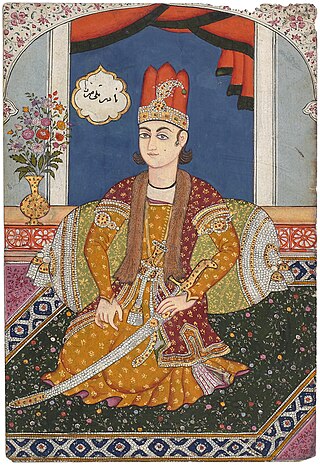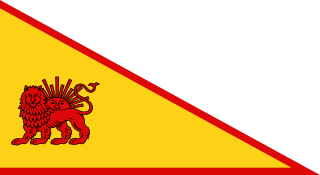
The Battle of Karnal, was a decisive victory for Nader Shah, the founder of the Afsharid dynasty of Iran, during his invasion of India. Nader's forces defeated the army of Muhammad Shah within three hours, paving the way for the Iranian sack of Delhi. The engagement is considered the crowning jewel in Nader's military career as well as a tactical masterpiece. The battle took place near Karnal in Haryana, 110 kilometres (68 mi) north of Delhi, India.

The Afsharid dynasty was an Iranian dynasty founded by Nader Shah of the Qirqlu clan of the Turkoman Afshar tribe.

The Hotak dynasty was an Afghan monarchy founded by Ghilji Pashtuns that briefly ruled portions of Iran and Afghanistan during the 1720s. It was established in April 1709 by Mirwais Hotak, who led a successful rebellion against the declining Persian Safavid empire in the region of Loy Kandahar in what is now southern Afghanistan.

Ali-qoli Khan, commonly known by his regnal title Adel Shah was the second shah of Afsharid Iran, ruling from 1747 to 1748. He was the nephew and successor of Nader Shah, the founder of the Afsharid dynasty.

Nader Shah Afshar was the founder of the Afsharid dynasty of Iran and one of the most powerful rulers in Iranian history, ruling as shah of Iran (Persia) from 1736 to 1747, when he was assassinated during a rebellion. He fought numerous campaigns throughout the Middle East, the Caucasus, Central Asia, and South Asia, such as the battles of Herat, Mihmandust, Murche-Khort, Kirkuk, Yeghevārd, Khyber Pass, Karnal, and Kars. Because of his military genius, some historians have described him as the Napoleon of Persia, the Sword of Persia, or the Second Alexander. Nader belonged to the Turkoman Afshars, one of the seven Qizilbash tribes that helped the Safavid dynasty establish their power in Iran.

The siege of Kandahar began when Nader Shah's Afsharid army invaded southern Afghanistan to topple the last Hotaki stronghold of Loy Kandahar, which was held by Hussain Hotaki. It took place in the Old Kandahar area of the modern city of Kandahar in Afghanistan and lasted until March 24, 1738, when the Hotaki Afghans were defeated by the Persian army.

Emperor Nader Shah, the Shah of Iran (1736–1747) and the founder of the Afsharid dynasty, invaded Northern India, eventually attacking Delhi in March 1739. His army had easily defeated the Mughals at the Battle of Karnal and would eventually capture the Mughal capital in the aftermath of the battle.

The Ottoman–Persian War of 1730–1735 was a conflict between the forces of Safavid Iran and those of the Ottoman Empire from 1730 to 1735. After Ottoman support had failed to keep the Ghilzai Afghan invaders on the Persian throne, the Ottoman possessions in western Persia, which were granted to them by the Hotaki dynasty, came under risk of re-incorporation into the newly resurgent Persian Empire. The talented Safavid general, Nader, gave the Ottomans an ultimatum to withdraw, which the Ottomans chose to ignore. A series of campaigns followed, with each side gaining the upper hand in a succession of tumultuous events that spanned half a decade. Finally, the Persian victory at Yeghevard made the Ottomans sue for peace and recognize Persian territorial integrity and Persian hegemony over the Caucasus.

The Battle of Yeghevārd, also known as the Battle of Baghavard or Morad Tapeh, was the final major engagement of the Perso-Ottoman War of 1730–1735 where the principal Ottoman army in the Caucasus theatre under Koprulu Pasha's command was utterly destroyed by only the advance guard of Nader's army before the main Persian army could enter into the fray. The complete rout of Koprulu Pasha's forces led to a number of besieged Ottoman strongholds in the theatre surrendering as any hope of relief proved ephemeral in light of the crushing defeat at Yeghevārd. One of Nader's most impressive battlefield victories, in which he decimated a force four or five times the size of his own, it helped establish his reputation as a military genius and stands alongside many of his other great triumphs such as at Karnal, Mihmandoost or Kirkuk.

The Battle of Samarra was the key engagement between the two great generals Nader Shah and Topal Osman Pasha, which led to the siege of Baghdad being lifted, keeping Ottoman Iraq under Istanbul's control. The armed contest between the two colossi was very hard fought with a total of roughly 50,000 men becoming casualties by the end of the fighting that left the Persians decimated and the Ottoman victors badly shaken. Other than its importance in deciding the fate of Baghdad, the battle is also significant as Nader's only battlefield defeat although he would avenge this defeat at the hands of Topal Pasha at the Battle of Agh-Darband where Topal was killed.

Reza Qoli Mirza Afshar (1719–1747) was the eldest son of Nader Shah, King of Afsharid Iran. After his father's coronation in 1736, Reza Qoli, aged 17, became the Governor of the important province of Khorasan. During his tenure, he showed courage by subduing rebellious khans and campaigning up until Bukhara to put an end to the Khanate of Bukhara, his father's enemies. Before heading off to India, Nader Shah appointed Reza Qoli the regent of Iran. As regent, Reza Qoli kept the peace intact but in doing so he was cruel, demanding taxes and executing people for mere crimes. He had Tahmasp II and Abbas III, two pretenders to the throne, killed, which caused an uproar among the people. When Nader Shah returned from India, he dismissed Reza Qoli as regent, snubbing him for his actions during the regency.

Nader's Dagestan campaign, were the campaigns conducted by the Persian Empire under its Afsharid ruler Nader Shah between the years 1741 and 1743 in order to fully subjugate the Dagestan region in the North Caucasus Area. The conflict between the Persian Empire & the Lezgins and a myriad of other Caucasian tribes in the north was intermittently fought through the mid-1730s during Nader's first short expedition in the Caucasus until the last years of his reign and assassination in 1747 with minor skirmishes and raids. The incredibly difficult terrain of the northern Caucasus region made the task of subduing the Lezgins an extremely challenging one. Despite this Nader Shah gained numerous strongholds and fortresses from the Dagestanis and pushed them to the very verge of defeat. The Lezgins however held on in the northernmost reaches of Dagestan and continued to defy Persian domination.

The military forces of the Afsharid dynasty of Iran had their origins in the relatively obscure yet bloody inter-factional violence in Khorasan during the collapse of the Safavid state. The small band of warriors under local warlord Nader Qoli of the Turkoman Afshar tribe in north-east Iran were no more than a few hundred men. Yet at the height of Nader's power as the king of kings, Shahanshah, he commanded an army of 375,000 fighting men which, according to Axworthy, constituted the single most powerful military force of its time, led by one of the most talented and successful military leaders of history.
Sheikh Rashid bin Matar Al Qasimi was Ruler of Ras Al Khaimah and Sharjah from 1747–1777, as head of the Al Qasimi maritime federation. Rashid bin Matar ruled at a time when maritime violence was prevalent throughout the Persian Gulf, following incursions by the Portuguese and fighting at sea and on land on the Persian Coast between the British and Dutch and the British and French, over 'factories' established on that coast by both maritime powers.
The 4th Region or the Northern Fleet is the flotilla of the Islamic Republic of Iran Navy in the Caspian Sea.
The navy of Achaemenids was the ancient navy of the Persian Empire that existed between 525 BC and 330 BC.

Afsharid Iran, also referred as the Afsharid Empire, was an Iranian empire established by the Turkoman Afshar tribe in Iran's north-eastern province of Khorasan, ruling Iran (Persia). The state was ruled by the Afsharid dynasty in the mid-eighteenth century. The dynasty was founded in 1736 by the brilliant military commander Nader Shah, who deposed the last member of the Safavid dynasty and proclaimed himself as the Shah of Iran.
The Rebellion of Sheikh Ahmad Madani was a revolt in the Garmsirat region of Iran from January 1730 as the Hotaks were being pushed out of Iran up until May 1734 when Sheikh Ahmad Madani was captured. However, remnants of the rebellion continued to fight until the middle of June 1734 before it was finally crushed.

Daryabegi was a naval title of Iran, which literally translates as "sea lord" in English. It was in use from the 18th century until the first quarter of the 20th century when it was abandoned. It thenceforth became an Iranian surname.
Mohammad Taqi Khan Shirazi was an 18th-century Iranian official who served as the governor of Fars under the Afsharid shah (king) Nader Shah from 1734 to 1744.
















